Georgia
| |
 |
Savannah |
Georgia |
USA |
Horizontal Dial |
Dial 705 |
| A 10 inch round bronze horizontal dial called "The Bull Sundial", sits on an octagonal stone atop a 3 foot high fluted pedestal. The pedestal is in the center of a 10 foot square plaza containing four tile mosaics.. Dial face has Roman numerals, hour lines, five minute marks and a central compass rose. This dial is located under a heavy canopy of trees and likely never gets direct sunlight today, |
| |
| |
 |
Savannah |
Georgia |
USA |
Armillary Sphere |
Dial 706 |
| A six foot diameter armillary sphere of steel and bronze with equatorial, meridian, equinoctial colure, ecliptic, Arctic and Antarctic rings. Equatorial ring has Roman hour numerals but no hour marks and includes gold plated Zodiacal symbols on exterior of ring. The sphere base is supported on the backs of cast tortoises atop a 3 foot high square marble pedestal. This dial is located under a heavy canopy of trees and likely never gets direct sunlight today. |
| |
| |
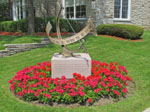 |
Scarborough |
Ontario |
Canada |
Equatorial Dial |
Dial 790 |
| A 45 inch diameter bronze equatorial ring dial with an arrow-pointed rod gnomon. The dial is mounted atop a 36 inch square pink granite plinth with chamfered corners sitting on a concrete base. |
| |
| |
|
Schroon Lake |
New York |
USA |
Horizontal Dial |
Dial 184 |
| 7-sided metal plate, about 9.75" on a side. Bronze. Unusual 7-sided dial plate, Arabic numerals. Hour and half-hour marks on outside rim. Image of bible and cross on plate left of gnomon, and 'Word of Life' on right. (These are the standard logo of the organization.) Fabricated by Colonial Brass Co, Middleboro MA. |
| |
| |
 |
Seaside |
Florida |
USA |
Horizontal Dial |
Dial 551 |
| A large horizontal dial with a steel gnomon much larger than the dial itself, yet aesthetically pleasing. The dial itself is an oval approximate 3 by 4 feet (1m by 1.1m) of concrete with bronze hour lines and numbers from 6am to 7pm. The dial and gnomon are surrounded by gravel, set in the center of a plaza contained by a 30 foot (10m) diameter hedge. |
| |
| |
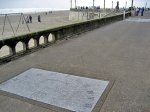 |
Seaside |
Oregon |
USA |
Analemmatic Dial |
Dial 583 |
| A granite analemmatic dial on the Promenade sidewalk near overlooking the beach. This dial, built in 1987, replaces an earlier dial painted on this sidewalk. Dial face is inscribed, "Enjoy your time in Seaside." While evoking the earlier painted dial, this new dial is not well designed and will have serious errors through the year. See the NASS Registry for a picture of the earlier painted dial. |
| |
| |
 |
Seattle |
Washington |
USA |
Gnomonic or Projection Dial |
Dial 577 |
| A colored-aperture projection calendrical sundial with one functional and four decorative 18 inch round clear stained glass apertures. Markings on floor indicate positions of projected orange light spot at solar noon from the spring to fall equinox. An additional noon mark indicates opening date of library. |
| |
| |
 |
Seattle |
Washington |
USA |
Vertical Dial |
Dial 744 |
| A 10 x 18 foot vertical dial on a south-facing brick wall. The hour lines are stainless steel sheet and are formed to create shadow effects that change with the position of the sun. The stainless steel Arabic hour numerals are on disks that are held on the wall by magnets, allowing them to be placed for ST or DST. A stylized school emblem is placed at the base of the gnomon. A round, two-sided plaque in the wall below describes the use of the dial, designed by Mindy Cameron of Lehrman Cameron Studio. |
| |
| |
 |
Seattle |
Washington |
USA |
Vertical Dial |
Dial 745 |
| A 12 x 30 foot vertical dial on a brick wall that declines 0.5? west of south. The 5 foot stainless steel gnomon tip carries a sheet metal sculpture of an eagle, the school mascot. The hour lines are aluminum strips terminating in Arabic hour numerals. The dial face includes ceramic disks painted by school students and are placed so that the gnomon shadow falls on then on their birthday. |
| |
| |
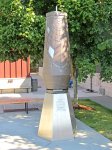 |
Seattle |
Washington |
USA |
Cylindrical Dial |
Dial 746 |
| A unique, 10 foot tall, 2 foot diameter (base) tapered cylinder dial similar to a traditional shepherd's dial except that the cylinder orientation is fixed and the gnomon is rotated about the dial axis by the user to align with the sun. Time is read from the vertical hour and date lines. The dial is fabricated from bronze plate and is hollow. Lines are formed by individually cut hour and date line segments welded on from inside the cylinder. A lever at hand height is moved to rotate the gnomon to face the sun, providing a vertical shadow. A slit in the gnomon tip provides a more accurate sun spot on the dial face. The cylinder is tapered top to bottom for aesthetics and to minimize the effect of solar altitude variation through the seasons. |
| |
| |
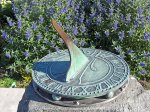 |
Seattle |
Washington |
USA |
Horizontal Dial |
Dial 747 |
| A 20 inch diameter cast bronze horizontal dial atop a 30 inch high one-piece stone pedestal. The dial face has cast quarter-hour marks and Roman hour numerals. The dial, built in 1912, has been refurbished and relocated several times and has a new bronze gnomon. Prof. Woody Sullivan and Kurt Kiefer did the last restoration in 2002. Dial times are inaccurate 5-7 minutes. |
| |
| |
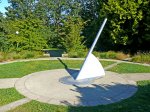 |
Seattle |
Washington |
USA |
Horizontal Dial |
Dial 748 |
| A 35 foot diameter horizontal dial of concrete and stainless steel with an 8 foot gnomon. Hour marks and Arabic hour numerals are shown on the inner circle and outer ring. A meridian line has markers for solstices and equinoxes, for cardinal directions and magnetic bearings. The dial was constructed using material obtained from Boeing Surplus. |
| |
| |
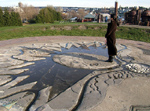 |
Seattle |
Washington |
USA |
Analemmatic Dial |
Dial 74 |
| 27-ft (8m) circle containing a fanciful analemmatic dial made of bronze and concrete with countless embedded items. Seattle Sundial Trails notes "It requires more than a casual look to recognize the paving that tops Kite Hill as a sundial. At first glance, it seems as if the high tide washed over a bed of fresh concrete, leaving lots of marine creatures and wave prints behind.....The structure is colored concrete, with many interesting inlaid objects scattered throughout, including a bronze bear claw, a ceramic crab, pieces of pottery and glass and shells, etc. Many features are in bronze (such as some hour numerals and the [zodiac walkway] on which one stands.... Bronze casts of three pairs of footprints are those of Greening, the (anonymous) donor of the piece, and the donor’s dog! There are, however, so many inlaid objects and the hour numerals are so stylized that the dial pattern is somewhat obscured." At the center of the dial is a large yin-yang symbol, made from light and dark concrete. Within this is the zodiac walkway to stand for casting the hour's shadow. However normal dates have given way to elongated bronze band loops around a wavy center line using zodiac signs to indicate the months. For example: Equinoxes are indicated by Aries and Libra while the summer solstice is the Tropic of Cancer and winter solstice is Tropic of Capricorn. |
| |
| |
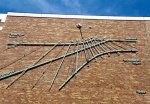 |
Seattle |
Washington |
USA |
Vertical Dial |
Dial 117 |
| Large vertical dial declining 36? west of south with hour lines, analemmal lines, sunrise and sunset limits, solstice lines. Metal structure mounted slightly away from brick building surface. Gnomon is a ball mounted on a rod emanating from sunburst. Visit the university of Washington web page to see this beautiful dial. |
| |
| |
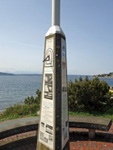 |
Seattle |
Washington |
USA |
Vertical Dial |
Dial 791 |
| A south facing vertical dial on a chamfered triangular pillar. The gnomon is slightly bent. The dial face includes hour lines with Arabic numerals for Pacific Standard Time and PDT, the approximate coordinates and the magnetic declination. |
| |
| |
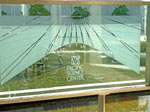 |
Seattle |
Washington |
USA |
Vertical Dial |
Dial 795 |
| A 4 foot wide by 1.5 foot high etched glass plate vertical dial. The gnomon is formed by crossed bars several inches behind the plate and casts its shadow on hour line analemmas. Roman hour numerals for 10 AM to 4 PM are scribed under each analemma; other hours are Arabic. Solstice and equinox lines are scribed across the plate, as are narrow lines at 10 day intervals. Months of the year are scribed about the plate perimeter. A description of the dial is marked on the left side of the plate and the fountains are visible through the plate |
| |
| |
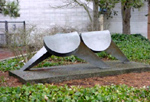 |
Seattle |
Washington |
USA |
Sculpture/Artwork |
Dial 306 |
| 3x9x4 feet cast bronze sculpture of two gibbous shaped circles, each with supports. The sculpture called "Gnomon" could have been better called "abbreviated millipede" |
| |
| |
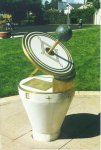 |
Seattle |
Washington |
USA |
Equatorial Dial |
Dial 315 |
| An interesting equatorial dial 30 inches in diameter, made of bronze and terrazzo, sitting upon a tapered concrete pedestal cylinder that almost, but not quite, looks like a large flower pot. The dial plate is plainly decorated with a gnomon pole about 1.5 inches in diameter. Sitting at the north end of the pole is a very nice globe of the earth with continents in relief. |
| |
| |
|
Sebastopol |
California |
USA |
Obelisk or Vertical Gnomon |
Dial 428 |
| This is a vertical obelisk 3 foot on a side and 9 foot tall. It is more of a sun calendar than a sundial. The tip of the obelisk's shadow is tracked by marks on a concrete pad on the ground. The summer and winter solstices and equinoxes are indicated by tiles set in the pad. |
| |
| |
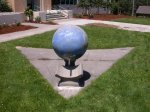 |
Sebastopol |
California |
USA |
Globe or Hemispheric |
Dial 522 |
| The sundial is a cement globe of the earth 28 inches in diameter inclined at 40 degrees, a bit off the site's 38' 20" N latitude. The globe is oriented with the site longitude on the upper meridian so that shadows across the globe represent the true sun angle at that moment. A rod through the globe casts a shadow onto the north polar regions in the summer. At the southern end is a small equatorial dial with hour lines from 8am to 4pm. |
| |
| |
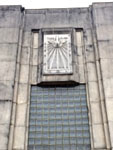 |
Senatobia |
Mississippi |
USA |
Vertical Dial |
Dial 792 |
| A south facing vertical dial placed above a window high on a wall of a high school. The dial face includes hour lines and Arabic hour numerals 6 AM to 6 PM. The dial is a separate plate affixed to the wall. The dial may be viewed from College Street side of the building. |
| |
| |
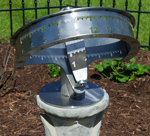 |
Sequim |
Washington |
USA |
Digital Dial |
Dial 1122 |
| This dial began as a Thewes Sundial with an equatorial arc with cut out hour numbers that illuminate a central plate. This original dial went missing in the 1970's.. But when the new stainless steel sundial with a 150mm radius equatorial arc was finished, it took the Thewes concept into the 21st Century. The equatorial arc not only has the hourly Arabic numbers, but has a row of finely cut marks every five minutes with very easily distinguishing shapes to see the hour, half, and quarter hour indicators. And rather than a central plate tilted to the site's latitude, this dial has a plate that rotates on the polar axis set at the center of the equatorial arc. |
| |
| |
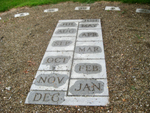 |
Sewickley |
Pennsylvania |
USA |
Analemmatic Dial |
Dial 910 |
| Sewickley is a borough in Allegheny County, Pennsylvania, 12 miles (19 km) west northwest of Pittsburgh along the Ohio River. Riverpark was created in 2010 with a meandering path. At one stop is a plain analemmatic sundial approximately 15 feet across on a gravel bed. Hour markers are granite stones showing 4am-8pm. The analemmatic walkway has engraved abbreviations of the months, looking like granite blocks, but actually clever and beautiful concrete. |
| |
| |
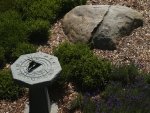 |
Sheboygan Falls |
Wisconsin |
USA |
Horizontal Dial |
Dial 550 |
| A 20 inch octagonal dial of bluestone on a 28 inch high base. The gnomon matches the latitude angle and the hour lines are approximate for a generalized geographic area. |
| |
| |
 |
Sheridan |
Wyoming |
USA |
Horizontal Dial |
Dial 840 |
| This monumental horizontal dial is 15 ft. in diameter sitting on a foundation of poured concrete and rebar. The dial face is etched on 4 large granite slabs from Canada. The gnomon is a 6-inch diameter steel pipe 97inches tall with a welded nodus ball and a triangular sheet beneath the gnomon that has a sun and the school logo (a mountain range) cut into it casting projected images onto the sundial face. |
| |
| |
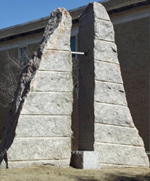 |
Sherman |
Texas |
USA |
Noon Mark or Meridian Dial |
Dial 902 |
| Outside the library are two stone granite guardians about 12 feet tall. They create a noon marker along a low stone wall set along the solar meridian. There are three markers rods set horizontally across the top of the wall that catch the shadow of a horizontal bar set between the two granite pillars. The shadow falls on the farthest horizontal rod on the wall at winter solstice. During the summer solstice, the shadow falls on the nearest rod to the granite block. And on the spring and fall equinox, the shadow falls on the middle rod. |
| |
| |
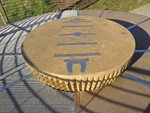 |
Shoreline |
Washington |
USA |
Analemmatic Dial |
Dial 796 |
| An 8 foot diameter concrete and pebble analemmatic dial with engraved stainless steel inserts for central date line and simple instructions for use. The dial face is raised one foot on a fluted column above the perimeter concrete and stainless steel walkway and has stainless steel Arabic hour numerals for 6 AM, 12 PM and 6 PM. The walkway has stainless steel inserts showing hour lines, magnetic north, true north, winter solstice, equinox and summer solstice directions. |
| |
| |
|
Shreveport |
Louisiana |
USA |
Horizontal Dial |
Dial 138 |
| Stone Dial vandalized. Gnomon missing, apparently knocked off with some damage to horizontal dial plate. Dial bears Roman numerals, from IV to VIII. |
| |
| |
 |
Sidney |
British Columbia |
Canada |
Armillary Sphere |
Dial 682 |
| A 20 inch diameter brass armillary sphere with equatorial, meridian and equinoctial colure rings. Gnomon has two nodus balls that may show solar position at solstices. Equatorial ring has 15-minute marks and Arabic hour numerals. The dial alignment needs adjustment for its current location. |
| |
| |
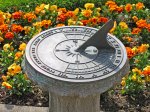 |
Sidney |
British Columbia |
Canada |
Horizontal Dial |
Dial 749 |
| A 10 inch diameter horizontal bronze dial with hour lines, quarter hour marks and Roman hour numerals. The dial face includes a central compass rose. The dial sits atop a fluted concrete pedestal. The dial is gnomonically correct, designed for latitude. |
| |
| |
 |
Silver Bay |
Minnesota |
USA |
Horizontal Dial |
Dial 227 |
| A horizontal dial on the ground, with an hour circle about 12 feet. The gnomon is of steel, about 4 foot high. The gnomon is oriented to magnetic north. It is not an accurate device. Three boulders surround the dial and cut off the shadow much of the time. Gravel hour circle has rocks to mark the hours, but the rocks can be moved and are strewn all about. More suggestive of a dial than a real dial. |
| |
| |
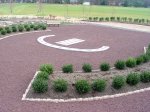 |
Skippack |
Pennsylvania |
USA |
Analemmatic Dial |
Dial 650 |
| A concrete and engraved brick analemmatic dial set in a garden of crushed rock. |
| |
| |
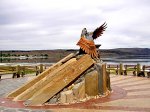 |
Soap Lake |
Washington |
USA |
Sculpture/Artwork |
Dial 652 |
| A monumental, 1-1/3 life-size bronze, steel and basalt rock sundial sculpture of a human figure with raised arm serving as a gnomon. The sculpture, "Calling the Healing Waters," depicts a young Native American couple as Father Sky and Mother Earth, sacred essence of rain and minerals connecting and bringing healing. Reflecting ethnic and historical themes, the winged warrior protects and comforts the maiden holding a catch basin for the healing waters. The sculpture was commissioned to honor the healing properties of the waters of Soap Lake. |
| |
| |
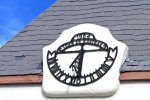 |
Solvang |
California |
USA |
Vertical Dial |
Dial 750 |
| A cast or wrought iron vertical dial about 3 foot square painted black, prominently mounted at the roof line of the Royal Copenhagen Inn. The dial face has hour lines, half-hour marks and Roman hour numerals. The dial in not quite gnomonically correct as the building declines a few degrees west of south and the gnomon appears to be at 45? rather than 34.5?. The dial is visible from Mission Road.
An interesting wind vane is seen on the roof peak above the dial. |
| |
| |
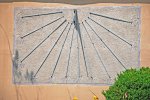 |
Somerville |
Massachusetts |
USA |
Vertical Dial |
Dial 441 |
| This 5 foot x 7 foot vertical dial is painted onto the true south facing concrete wall of a commercial building. The gnomon and hour lines appear to be weathered copper or bronze. The hour lines are corrected for longitude, but may be in error by about 5 minutes. The dial is in relatively good condition, but the painted numerals are fading. The building itself has been in several hands over the last 10-15 years. |
| |
| |
 |
South Bend |
Indiana |
USA |
Compound Dial |
Dial 710 |
| A combination horizontal dial with nodus on its gnomon and a meridian projection dial located below. Horizontal dial face is 44 inches diameter and made of polished Chinese gabbro basaltic rock, reflecting clouds overhead and gnomon shadow, which shows location of solar noon on gnomonic projection map of the world on dial face. Gnomon is supported by curved triangular bronze arches. Gnomon nodus shadow shows location on map where sun is directly overhead while solstice and equinox lines indicate date. Hour markers show EDST by Roman numerals with ten minute increments by Arabic numerals and marks for one minute. Dial is supported on an octagonal limestone pedestal with French Gothic cathedral window design allowing viewing of meridian dial date line.
Meridian dial is placed below the octagonal limestone pedestal whose French Gothic cathedral window design allows the noon date line to be seen. The date line is illuminated only at noon by sunlight passing through a slit orifice that extends 2/3 the way up the pedestal wall, indicating dates between summer and winter solstice by the end of the end of the bar of light.
The entire combination dial sits on a plaza inlaid with three types of granite to form a 32 foot diameter compass rose, with sunrise and sunset times shown for sixteen dates special to Notre Dame University. |
| |
| |
 |
South Burlington |
Vermont |
USA |
Sun Alignment |
Dial 695 |
| A calendrical dial sculpture of light beams projected onto the crushed stone surface of a 60 foot diameter meditative labyrinth. Two cylindrical focusing mirrors are located atop 10 foot poles and project short bars of sunlight that wander around the labyrinth but intersect on the equinoxes and winter solstice to form a cross at the center of the labyrinth at solar noon. |
| |
| |
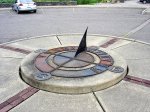 |
South Burlington |
Vermont |
USA |
Horizontal Dial |
Dial 264 |
| An 8 foot wrought iron steel horizontal dial. Design is of two circles enclosing one another and quartered. Outer circle is 11 foot wide with beaded edges and Roman hour numerals. Inner circle is 3'4" diameter quartered disk. Surveyed in 1992, finding condition very poor; steel dial is rusted. No motto or plaque is provided. |
| |
| |
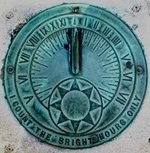 |
South Hadley |
Massachusetts |
USA |
Horizontal Dial |
Dial 338 |
| This is known as the Mary Deacon Bullard Sundial. It is a bronze-patina horizontal dial about 16 inches in diameter, with a plain gnomon that rises about 6 inches. The chapter ring has time divided into quarter hours. Roman numerals grace the dial from 5am to 7pm. The dial face has an offset 8-point compass rose The dial sits on an ornate stone pillar resting on a two-step octagonal base. |
| |
| |
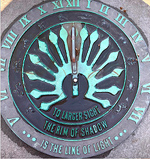 |
South Hadley |
Massachusetts |
USA |
Horizontal Dial |
Dial 177 |
| ca 18 inch diameter horizontal dial. Roman numerals, 5 AM to 7 PM. Zodiac signs in circle within numerals. Capricorn and Sagittarius misplaced. The gnomon was replaced in 1991, but again has been vandalized. Dial sits atop a granite 4-finned pillar with circular granite capital. |
| |
| |
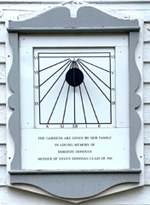 |
South Hadley |
Massachusetts |
USA |
Vertical Dial |
Dial 995 |
| This vertical dial is a quaint and simple sundial made of wood. It is nearly square in shape with hour lines radiating from the gnomon. The hours are marked at the edge of the square in small Roman numerals. There are no solstice or equinox lines. The black disk on the dial face is the base of the gnomon. |
| |
| |
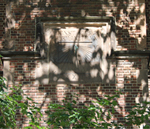 |
South Hadley |
Massachusetts |
USA |
Vertical Dial |
Dial 996 |
| This vertical sundial declines slightly to the southwest in alignment with the building wall. The 1x1 meter dial is of concrete and built in the middle of the south wall. Because of its size and height at least 25 feet above ground, it was made to be seen at a distance. In 1916 when it was built, the land to the south was clear and many early photographs show the dial prominently on the south face One hundred years later many trees block the sunlight to this fine sundial. The dial is delineated in half-hour lines spanning from the 7:30am line in morning to the 6pm hour line in the evening. The hour lines are marked with Roman numerals. There are no solstice or equinox lines. |
| |
| |
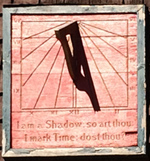 |
South Lee |
Massachusetts |
USA |
Vertical Dial |
Dial 838 |
| On the transom of a brown wood shingled and stone building that looks like it once was a church is a vertical south declining wooden sundial about 2 x 2 feet square. The sundial is painted red with a nicely cut wood gnomon. Hour lines and Roman numerals from VI to VI are chiseled into the wood, along with an inscription. The dial is framed in wood as well but the contrasting grey paint is flaking off. |
| |
| |
 |
South Woodstock |
Vermont |
USA |
Vertical Dial |
Dial 569 |
| A painted 47x72 inch vertical dial of red oak declining east. Markings include analemmas for each hour, solstice declination lines and day lines for the first of each month with Zodiac icons on perimeter. Contact dial designer David Scott to arrange viewing. |
| |
| |
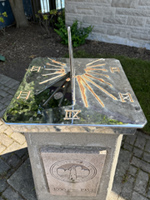 |
Southampton |
Ontario |
Canada |
Horizontal Dial |
Dial 1094 |
| A simple horizontal dial marked with solar hours, unusual in having a reflective chrome coating of the entire dial (in some spots the chrome has flaked off where the underlying material has started to rust). The gnomon is a triangular vane with a pattern of round holes pierced though it. The dial face is approximately 20" (50cm) square and wraps down at the edges to make a 3" (7.5cm) high block. It stands on a square concrete column about 3' (1m) high, which also contains a hidden Time Capsule. |
| |
| |
|
Sparkill |
New York |
USA |
Vertical Dial |
Dial 145 |
| 11' H x 7' W x 2' D. Mosaic tile and bronze Entitled 'Thorpe Village Sundial' |
| |
| |
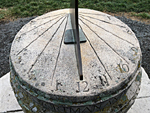 |
Spokane |
Washington |
USA |
Horizontal Dial |
Dial 1074 |
| The stone dial is approximately 24 inches (61 cm) in diameter with a large brass gnomon whose foot is considerably offset to the south. Simple hour lines with Arabic numbers from 7am to 5pm facing outward. The dial is approximately 2 inches (5 cm) thick with a band for inscription directly below. All this sits on a 12-sided pedestal of slightly larger diameter. On each slender side of the pedestal is an embossed sign of the zodiac. Lichens have taken hold on parts of the dial and pedestal. The sundial is a memorial to the two sons of Mr. and Mrs. R. Jackson Wortman. Jacob J. Wortman died at age 15 after a lingering illness. Ward K. Wortman, a fighter pilot in the Air Corps, was killed in action. |
| |
| |
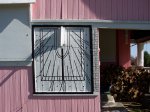 |
Springfield |
Vermont |
USA |
Vertical Dial |
Dial 542 |
| A 52x55 inch painted wood vertical dial designed and built by Russell Porter. The wood gnomon is stabilized by copper sheet. Available for viewing at the summer Stellafane Telescope Makers conference or by arrangement by email with owner. |
| |
| |
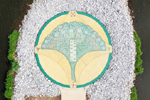 |
Springfield |
Missouri |
USA |
Analemmatic Dial |
Dial 1130 |
| Situated on a peninsula extending into Lake Drummund, this 25-foot (7.6m) double-ring analemmatic (human) sundial is easily seen on Google Earth. The mosaic dial shows both standard (6am-6pm) and daylight savings hours (7am-7pm). |
| |
| |
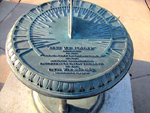 |
Springfield |
Illinois |
USA |
Horizontal Dial |
Dial 1121 |
| This is a classic Grand Army of the Republic (GAR) sundial. It is a bronze, horizontal sundial approximately 24 inches (61cm) in diameter, with an ornate design of ovals at the exterior, sloping down to 30 inches in diameter. Hours are marked from 5am to 7pm in Roman numerals. Time is marked in quarter hours. The gnomon is solid with a simple under-curve. The whole dial rests on four upright pillars which sit on a circular bronze base. This is one of a series of bronze sundials presented by Daughters of Union Veterans of the Civil War, dedicated to the memory of the Grand Army of the Republic. |
| |